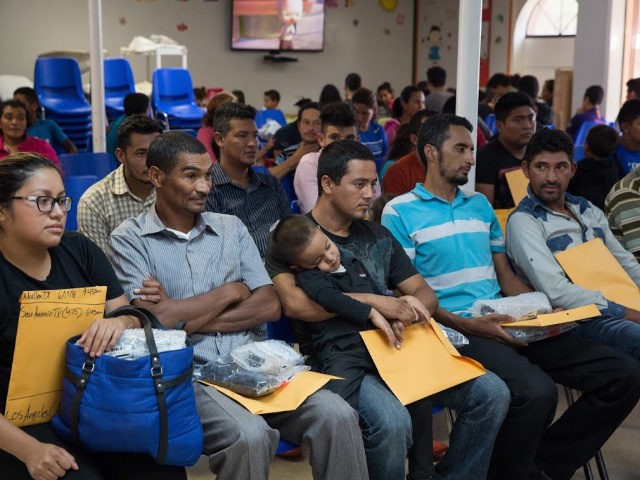The $1.2 trillion infrastructure bill provides roughly $2.5 billion to help the U.S. government expand the border processing stations used by migrants from poor Central American nations and other regions around the world.
Washington elites want “to speed travel across the border rather than impede it, and they’re not too worried about whether that travel is legal or illegal,” said Mark Krikorian, director of the Center for Immigration Studies.
The 2,702-page bill, titled the Infrastructure Investment and Jobs Act, includes $2.5 billion for facilities to accelerate the cross-border flow of goods, business travelers, and job-seeking migrants. Up to 18 GOP Senators partially back the bill.
The growing inflow of migrant workers is being cheered by U.S. employers and investors who are eager to hire cheap and compliant workers, and to sell goods, services, and housing to customers. More than 600,000 economic migrants have moved into the United States since January 2021, so damaging Americans’ opportunities, wages, rents, productivity, and political status.
The $2.5 billion in border infrastructure spending plan is in addition to the annual budget request for 2022 spending by the Department of Homeland Security (DHS).
The DHS plan asks for “a $655 million dollar investment toward modernizing our land Ports of Entry,” according to July 27 testimony provided by DHS secretary Alejandro Mayorkas. His statement continued:
Consistent with the President’s recently released Immigration Blueprint calling for safe, orderly, and humane policies and practices to govern immigration …
It includes a new discretionary request for $345 million for U.S. Citizenship and Immigration Services to reduce the backlog of applications and petitions, ramp up interview capacity, and meet our goal of welcoming up to 125,000 refugees per year. To ensure the safe and humane treatment of migrants at the Southwest Border, the request includes $163 million for medical needs for those in Customs and Border Protection custody.
Officials have not announced plans to build more detention centers for the economic migrants, even though such detention is required by federal law.
Last week, the administration described its plans to import more consumers and workers. And on July 28, officials unveiled a plan called the “Collaborative Migration Management Strategy” (CMMS), which would welcome more migrants from Central America. These planned inflows would be in addition to the existing legal inflow of roughly one million immigrants per year, plus the churning resident workforce of roughly 2.5 million visa workers.
The CMMS plan says:
The United States will enhance outreach and engagement with U.S. employers; work with Northern Triangle governments, international organizations, civil society, and the private sector to develop a more robust pipeline of Northern Triangle nationals who can meet the needs of U.S. employers when there are insufficient U.S. workers who are qualified and available to perform the work.
The infrastructure bill includes much funding to help implement Biden’s pro-migration plans, mixed in with bipartisan plans to detect drug trafficking and to speed transit by trucks and autos.
On page 2,543, the infrastructure bill says:
For an additional amount to be deposited in the ‘‘Federal Buildings Fund’’ … $2,527,808,000 shall be for projects on the U.S. Customs and Border Protection five-year plan.
On page 2,545, the bill provides funds to equip the border welcome centers:
For an additional amount for ‘‘Operations and Support’’, $330,000,000, to remain available until September 30, 2026, for furniture, fixtures, and equipment for the land ports of entry …
On page 2,546, the bill offers “$100,000,000, to remain available until September 30, 2026, for land port of entry construction, modernization, and sustainment.”
The bill also includes much extra spending for DHS’s Federal Emergency Management Agency, which is now used to help transfer migrants to new homes after they are released at the border. On page 2,551, the bill says:
For an additional amount for ‘‘Federal Assistance’’, $2,233,000,000, which shall be allocated as follows: (1) $500,000,000, to remain available until expended, for grants pursuant to section 205 of the Robert T. Stafford Disaster Relief and Emergency Assistance Act …
In contrast, Congress provided just $1.5 billion in 2020 for the border wall.
“To the extent that they change the asylum system so that people who present themselves of the border … this [construction] would make it much more viable to come in, to use an asylum claim as a way of gaining access to the United States,” said Krikorian.
“That wouldn’t be just for Central Americans; it would be beneficial to all the people from around the world — South Americans, Africans, and Asians — who are now making up a larger and larger portion of the inflow,” Krikorian added.
The infrastructure bill must survive a 60-vote procedural vote before it can get a final to pass out of the Senate. So far, 18 GOP Senators voted to start debate on the bill, but some may withdraw their support before the final vote:
- Roy Blunt (R-MO)
- Richard Burr (R-NC)
- Shelley Moore Capito (R-WV)
- Bill Cassidy (R-LA)
- Mike Crapo (R-ID)
- Lindsey Graham (R-SC)
- Mitch McConnell (R-KY)
- Lisa Murkowski (R-AK)
- Rob Portman (R-OH)
- Jim Risch (R-ID)
- Mitt Romney (R-UT)
- Thom Tillis (R-NC)
- Todd Young (R-IN)
- Chuck Grassley (R-IA)
- John Hoeven (R-ND)
- Kevin Cramer (R-ND)
- Susan Collins (R-ME)
Overall, legal and illegal migration moves wealth from employees to employers, from families to investors, from young to old, from children to their parents, from homebuyers to investors, from technology to stoop labor.
Immigration also moves wealth from heartland red states to the coastal blue states. Within each state, the extraction policy also helps move wealth and status from the GOP’s rural districts to the Democrats’ cities.

COMMENTS
Please let us know if you're having issues with commenting.